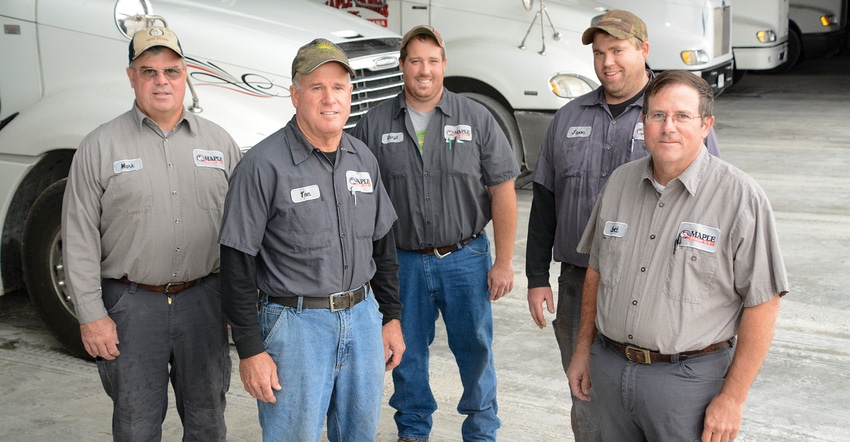February 3, 2020

When Scott, Tom and Mark Maple decided to restructure their northern Indiana family farm, the colossal chore’s complexities were beyond their capabilities. But by working with legal and ag-savvy financial pros, they were assured all the i’s were dotted and t’s crossed.
The three and numerous other family members own Maple Farms Inc. in Kokomo, Ind. Through strategic management to separate owned land and other assets from farm operations, they maintained and strengthened the legacy of the farm’s founders Clifford and Edna and their sons Bill and Charlie.
The farm’s early production included corn, soybeans, wheat and hogs. Bill and Charlie were partners in the 1950s and incorporated in the early ‘70s. Charlie’s son Tom and Bill’s son Mark joined the operation in the mid-70s. Bill’s son Scott joined the farm in the mid-90s after a stint as a vo-ag teacher. In recent years, Tom’s sons Daryl and Jason also joined the operation.
In 2006, the Maples left the hog business to concentrate more on grain farming. Crop production has grown to about 5,700 acres, much of which is land rented from long-time landlords.
Separating assets
In 2016 Maple Farms made a major transition to keep the legacy intact through its fourth and even fifth generation. They kept Maple Farms Inc. as a land holding and asset company. Then, Maple Age Inc. and TMS Farms, which was renting the farmland, formed Maple Farms GP. They own the main farm operation and are the only farm renting entity.
Initial restructuring came in the ‘70s incorporation. When Tom, Mark and Scott got involved, more direction was needed to assure the operation could financially support all of the families.
Most production is conventional tillage. They grow primarily food-grade corn and some non-GM corn. Commercial and seed soybeans and wheat are also grown and production includes some strip till and cover crops.
As farm acres grew, more tile installation was needed. In the late ‘90s, they bought a ditching machine. They added custom ditching, Maple Drainage, LLC, to their operation.
“Our major restructuring came after we realized that simply being incorporated wasn’t enough to handle growth in family members involved and acres being farmed,” Scott says.
Third Party Help
As family involvement grew, they worked closely with their CPA and attorney, who specialized in crop and livestock production issues.
“Restructuring is best done with a third-party facilitator,” Scott says. “Once all parties agree on where they want to end up, it makes it easier to figure out how to get there.
“A CPA and attorney can help avoid missteps that may be costly to unwind later. It’s important that those professionals have experience working with ag clients in order to understand concerns unique to our industry. One of those is understanding FSA guidelines on entity structures.”
Matt Folz, an attorney with Dobbs Legal Group, Peru, Ind., says restructuring impacts who receives those payments and how they are distributed under farm program provisions.

“Someone with expertise is needed to make sure payments are not limited in a restructuring plan,” Folz says, noting that Market Facilitation Program (MFP) payments are an example of the need for ag-management knowhow.
“Before getting with a third party, get detailed records of those assets. What land or equipment do you own? Once you identify what you own, and you have a plan, get with a professional, CPA or attorney, that can guide you in implementing that plan.”
Trent Wolfe, CPA with Kline’s CPA Group, Huntington, Ind., says restructuring allows farm operators to leave the correct type of assets to future farm heirs. “When an active farm operation is left to non-farm heirs, the decision-making may be left to those non-farm heirs,” he says. “It’s important to find professionals who understand the industry you are involved in, as they will have likely drafted a plan for similar situations.”
Assets and taxes
These are two key reasons to consider restructuring. “Farmers and their advisers should always discuss whether they can switch to a more tax-friendly entity or business structure, Folz says. “Instead of being a corporation or sole proprietorship, maybe they can transition into a different entity to save on taxes.”
Asset management typically goes up another notch in the restructuring process. “Assets are often owned in a way that make it difficult to efficiently pass to a successor,” Folz says. “Farms are often set up as a sole proprietorship, or a ‘Schedule F’. But when it comes to adding a successor, it usually helps to transfer those assets into a formal business entity, such as a limited liability company (LLC).
“Instead of giving or selling a fraction of each asset, it’s easier to give a fraction of the ownership in the entity.”
If farmers plan to gradually sell ownership, that strategy is often preferred. “Legal documents are a must,” Folz says. “It’s important to spell out the terms of that joint venture, so each person knows what happens to the farming operation when events like death happen.”
Land vs. operations – The Devil is in the details
A “farm” is typically two businesses – the land and the operations and should be treated differently. “Farmers understand that they don’t necessarily need to own the land, as long as they can maintain access to it for crop production,” says Folz, whose law firm worked with the Maples to establish land ownership guidelines.
For example, the elder farmer has three children, one son farming and two daughters not farming. If the farm has 1,000 production acres, it can be structured to facilitate all three. “The land can go into a separate entity that all three can inherit,” Folz says.
“The governing documents of that entity can require the land be rented to the farming son. The children own the land, but the entity stipulations maintain the successors right to farm the land. If a farmer is adamant about trying to treat his children equally, that’s the easiest way – but the devil is in the details.”
Include lease requirements in documents, along with details of the lease. “The rent rate is important to avoid disagreements,” he says, adding that lease terms are usually based on local rates established by Extension or other governmental entities, Movable rates based on future market conditions.
“Also, the documents are usually written to require unanimous approval before ground can be sold or mortgaged. This gives the farming child a ‘veto,’ allowing them to prevent other owners from selling the land.”
Wolfe agrees that transitioning the farmland to a separate entity allows for multiple benefits for the operation. “As current owners continue to own the entity, the cash rent income will likely generate cash for income distributions, plus some additional cash,” he says.
“The cash can be saved for farm expansion, shareholder buyouts or additional income distributions. If the land entity would pay income distributions that regularly exceed income tax due on income, shareholders may not have a desire to sell, since a return on investment is paying an annual distribution.”
The Maples saw the benefit of separating the operating entity from the land entity. “We knew we would get to the point where second cousins would have ownership of our business,” Scott says. “It’s fine if they own into the land. They are still entitled to the equity they deserve.
“But we also don’t want them influencing our daily operation, when they may be far removed from what we do.”
A frequent Farm Futures contributor, Stalcup writes from Amarillo, TX
About the Author(s)
You May Also Like




